Bearings are critical components in many mechanical systems, playing a vital role in reducing friction and supporting rotational motion.
However, they can fail due to various reasons, leading to costly downtime and repairs.
Understanding the common types of bearing failures, their diagnosis, and effective prevention strategies is essential for maintaining operational efficiency in machinery.
This article delves into the most prevalent bearing failures, how to diagnose them, and preventive measures to extend bearing life.
Common Types of Bearing Failures
1. Wear and Tear
Description: Over time, bearings experience wear due to friction, which can lead to surface degradation. This can manifest as pitting, spalling, or flaking on the raceways or rolling elements.
Diagnosis: Visual inspection is often the first step in diagnosing wear. Signs include discoloration, rough surfaces, and loss of material. Vibration analysis can also indicate wear patterns by detecting changes in amplitude and frequency.
Prevention: Regular lubrication is crucial to minimize friction. Using the correct type and amount of lubricant can reduce wear significantly. Additionally, ensuring proper alignment and load distribution can prevent premature wear.
2. Overheating
Description: Excessive heat can cause bearing failure by degrading lubricants, altering material properties, and leading to distortion.
Diagnosis: Signs of overheating include discoloration of the bearing surfaces, melted grease, and abnormal vibrations. Temperature monitoring tools can be employed to track the operating temperature of bearings.
Prevention: Proper lubrication, cooling systems, and ensuring that bearings are not overloaded are key to preventing overheating. Regular maintenance checks can help identify any issues that might lead to overheating.
3. Contamination
Description: Contaminants such as dust, dirt, and moisture can infiltrate the bearing and cause damage, leading to corrosion and wear.
Diagnosis: Inspection for discoloration, the presence of foreign particles, or rust is essential. A grease analysis can help identify contamination levels.
Prevention: Implementing effective sealing solutions and regular maintenance practices can minimize contamination. Keeping machinery clean and using appropriate protective measures during operation can also help.
4. Misalignment
Description: Misalignment occurs when the bearing’s shaft and housing are not properly aligned, leading to uneven load distribution and increased stress on the bearing.
Diagnosis: Misalignment can be diagnosed through vibration analysis, which shows distinct patterns indicative of misalignment. Visual inspections can also reveal signs of uneven wear on the bearing surfaces.
Prevention: Ensuring proper installation and regular alignment checks can prevent misalignment. Utilizing alignment tools can help achieve and maintain accurate alignment during installation.
5. Fatigue Failure
Description: Fatigue failure occurs when the material experiences cyclic stress beyond its endurance limit, leading to cracks and eventual fracture.
Diagnosis: Early signs include the appearance of small cracks on the bearing surfaces. Vibration analysis and acoustic emission monitoring can help detect fatigue failure before it leads to catastrophic failure.
Prevention: Using bearings designed for specific load conditions and implementing stress-relief techniques can help mitigate fatigue failure. Regular inspections and load monitoring are also important.
6. Lubrication Failure
Description: Inadequate lubrication can lead to increased friction and wear, resulting in premature bearing failure.
Diagnosis: Signs of lubrication failure include increased operating temperatures, unusual noise, and excessive wear patterns. Lubricant analysis can reveal degradation or contamination.
Prevention: Establishing a proper lubrication schedule and using the correct lubricant type for the application can prevent lubrication failure. Training operators on proper lubrication techniques is also vital.
Diagnostic Techniques for Bearing Failures
Effective diagnosis of bearing failures is essential for preventing future issues. Some common diagnostic techniques include:
- Visual Inspection: Regular visual inspections can identify early signs of wear, contamination, or misalignment.
- Vibration Analysis: This technique helps identify abnormal vibrations caused by wear, misalignment, or imbalance in the system.
- Temperature Monitoring: Continuous temperature monitoring can help detect overheating and lubrication failures.
- Lubricant Analysis: Testing the lubricant can reveal contamination levels, degradation, and the presence of wear particles.
- Acoustic Emission Monitoring: This technique detects high-frequency sound waves generated by material deformation, which can indicate early signs of fatigue or other failures.
Preventive Measures
To minimize the risk of bearing failures, implement the following preventive measures:
- Regular Maintenance: Establish a maintenance schedule that includes inspections, lubrication, and alignment checks.
- Proper Lubrication: Ensure that the correct lubricant is used and applied at regular intervals, and monitor the lubricant condition.
- Environmental Controls: Implement measures to minimize contamination, such as using seals and protective covers.
- Load Management: Ensure that bearings are not overloaded and are used within their specified limits.
- Training and Awareness: Educate operators and maintenance personnel about the importance of proper handling, lubrication, and alignment of bearings.
Conclusion
Understanding the common types of bearing failures and their diagnosis is essential for maintaining the efficiency and reliability of machinery.
By implementing effective preventive measures, organizations can reduce the likelihood of bearing failures, minimizing downtime and repair costs.
Regular maintenance, proper lubrication, and awareness of potential issues will significantly extend the life of bearings, ensuring smooth and efficient operations in various applications.
Also Read
Traditional vs. bonded warehousing: Which is right for you
The role of thrust bearings in high-load applications


